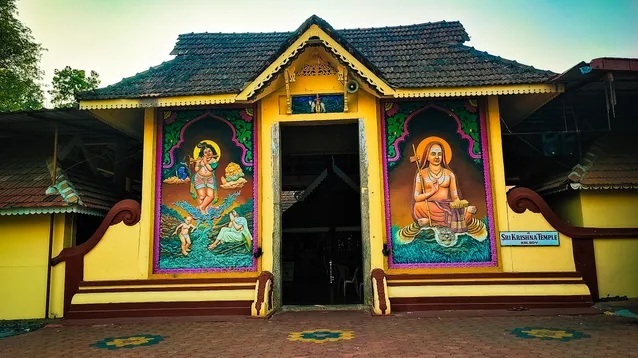“Shruti Smruti PurananAm Alayam KarunAlayam NamAmi BhagavAtpada Shankaram Loka Shankaram”
The Greatness of the Incarnation of Adi Shankaracharya: The Flame That Rekindled Dharma
In the long and sacred timeline of Bharat’s spiritual history, few figures shine as brilliantly and timelessly as Adi Shankaracharya. Born in a time when the light of Vedic wisdom was flickering under the weight of confusion, ritualism, and decay, he emerged as a divine incarnation—an embodiment of Lord Shiva himself, born not just to teach, but to revive, unify, and uplift.
A Divine Birth
According to tradition, Adi Shankaracharya ( 507-475 BC) was born in Kalady, Kerala 2500 yrs back , to a devout Nambudri Brahmin couple Sri Shivaguru , Mata Aryambaa Devi, after years of penance and prayer. His birth itself is considered divine, foretold by Lord Shiva, who is believed to have incarnated in this form to restore Sanatana Dharma.
( Krute Vishva Guru Tetayaam Rushi Sattamah , Dvapare Vyasa Eva syat Kalau atra Bhavishyam Aham )
( Kaliyuge Dvi Shahasrante Shankaro Avatarishyati )
From a young age, at the age of 8th only ( Ashta Varshe Chaturvedi , Dwadashe Sarva Shastravit, Shoshadhe Krutavan Bhashyam, Dwatrimshat Munirabhyagaat , ) Shankara displayed extraordinary intellect, detachment, and spiritual longing. He mastered the Vedas by the age of eight and took sannyasa (monastic vows) at a very young age, driven by a deep inner calling to seek truth beyond ritual and form.
The Mission: Reestablishing Sanatana Dharma
During Shankara’s time 507–475 BCE, India was grappling with:
- Fragmented religious schools,
- A decline in Vedic understanding,
- Rise of nihilistic or overly ritualistic sects,
- Foreign invasions and philosophical confusion.
Into this landscape, Adi Shankaracharya stepped as a spiritual reformer, philosopher, mystic, and yogi. His mission was not to create something new, but to restore what was eternal.
1. Propounding Advaita Vedanta: The Philosophy of Non-Duality
At the heart of his teachings lies Advaita Vedanta, the philosophy of non-dualism, which proclaims:
“Aham Brahmasmi – I am Brahman.”
“Tat Tvam Asi – Thou art That.”
According to Shankara, there is only one reality—Brahman, pure consciousness. The world of names and forms is maya (illusion), and liberation comes from the realization that the individual self (Atman) is not separate from the Supreme (Brahman).
This simple yet profound philosophy cut through sectarianism and illusion, reuniting seekers with the essential truth of the Upanishads.
2. Reviving Temples and Tirthas
Sri Adi Shankaracharya didn’t stop with philosophy. He took direct action:
- Reestablished ancient temples that had been forgotten or damaged.
- Revived spiritual sites like Badarikashram, where he reinstalled the Vigraha of Sri Badrinarayana.
- Restored Kedarnath, Pashupatinath, and other shrines with proper rituals and Vedic authority.
He made pilgrimage not just a religious act, but a national unifier, tying together the north and south, east and west of Bharat.
3. Establishing the Four Mathas: Guardians of Dharma
Jagadguru Sri Shankaracharya founded four mathas (monastic centers) in the four corners of India:
2500 Years ancient Jagadguru Adi Shankarachaya 4 Amnaya Peethams
Jagadguru Sri Sureshwaracharya 1st Acharya of the Dwaraka Sri Sharada Math in the West
Jagadguru Sri Padmapadacharya 1st Acharya for the Puri Sri Govardhana Math in the East.
Jagadguru Sri Hastamalakacharya 1st Acharya of Sringeri Sri Sharada Math in the South.
Jagadguru Sri Totakacharya 1st Acharya of Badari Sri Jyotir Math in the North.
- Sringeri Sharada Peetham (South)
- Dwaraka Sharada Peetham (West)
- Govardhan Matha, Puri (East)
- Jyotir Math, Badrikashram (North)
Each matha was placed under the guidance of one of his direct disciples and charged with preserving Advaita Vedanta, training monks, and serving as spiritual lighthouses for centuries to come.
4. A Life of Miracles, Debate, and Compassion
Adi Shankara’s life is filled with awe-inspiring episodes:
- Defeating great scholars across India in philosophical debate, yet with humility and grace.
- Engaging with Buddhist and Sankhya philosophers, not with arrogance, but to elevate understanding.
- Performing miracles—from reviving a dead boy to calming floods—not for display, but to inspire faith in dharma.
- Teaching the unity of Shiva and Vishnu, transcending sectarian boundaries.
Works known to be written by Shankara himself are the Brahmasutrabhasya, his commentaries on ten principal Upanishads, his commentary on the Bhagavad Gita, and the Upadeśasāhasrī.
He also composed timeless hymns like:
- Bhaja Govindam
- Atma Shatakam (Nirvana Shatakam)
- Soundarya Lahari
- Vivekachudamani
These works continue to awaken hearts and minds to this day.
5. Moksha at a Young Age
Remarkably, Adi Shankaracharya completed his divine mission by the age of 32 attained maha Nirvanam at Kedarnath,
But his spirit never left. His teachings, institutions, commentaries on the Upanishads, Bhagavad Gita, and Brahma Sutras live on, guiding countless seekers across centuries.
Conclusion: A Timeless Avatar of Wisdom
Adi Shankaracharya was not just a philosopher or monk—he was a living embodiment of divine knowledge, a Jagadguru (world teacher), and a bridge between form and formlessness. His incarnation was not merely for his time, but for all time.
He reconnected a fragmented world to the oneness of Brahman, and through that, gave each soul a path to liberation, devotion, and inner peace.
As he once declared in his Nirvana Shatakam:
“Chidananda rupah shivoham shivoham”
“I am pure consciousness and bliss—I am Shiva, I am Shiva.”
Such was the greatness of the incarnation of Adi Shankaracharya—the flame that lit a thousand lamps, and still burns bright.
“Shankaram Loka Shankaram”
IMP Docs



